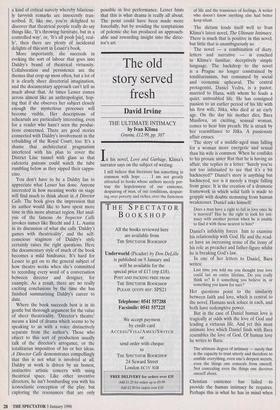What is gained in interpretation
James Treadwell
A DIRECTOR CALLS by Wendy Lesser Faber, £9.99, pp. 257 by Wendy Lesser Faber, £9.99, pp. 257 Audiences are no longer frightened by the mere mention of 'director's theatre'. We've lost our innocence: everyone can afford to be blasé about Sheridan in drag, post-industrial Shakespeare, Brecht on stilts. 'Director's opera' is still a phrase to freeze the blood of conservative critics, but the spoken stage has produced enough undisputed masterpieces of weird and wonderful directorial interpretation to reassure everyone. One of the more recent triumphs of this sort was Stephen Daldry's intense, operatic version of J. B. Priestley's An Inspector Calls, which began at the National before transferring to Broadway and the West End.
Wendy Lesser was apparently prompted by this show to write A Director Calls, a readable, informative discussion of how interpretation is produced in the theatre. In order to avoid inaccessible academic speculations, she hangs her central question — what directors do, and how they do it — on to what is effectively a theatrical biography of Daldry. Chapters are devoted to his tenure at the Royal Court, with detailed accounts of his work on Meredith Oakes's The Editing Process and Ron Hutchinson's Rat in the Skull, as well as Daldry's own strange workshop piece, Body Talk. These make very interest- ing reading, although Lesser's breathless admiration for Daldry sometimes produces a kind of critical naivety whereby hilarious- ly luvvyish remarks are innocently tran- scribed. If, like me, you're delighted to discover that theatrical people really do say things like, 'It's throwing furniture, but in a controlled way', or, 'It's all pooh [sic], real- ly', then there are plenty of incidental delights of this sort in Lesser's book.
More importantly, she succeeds in evoking the sort of labour that goes into Daldry's brand of theatrical virtuosity. Collaboration and persistence are the themes that crop up most often, but a lot of it is clearly sheer directorial imagination, and the documentary approach can't tell us much about that. At times Lesser comes across almost like an anthropologist, hop- ing that if she observes her subject closely enough the mysterious processes will become visible. Her descriptions of rehearsals are particularly interesting, even for a reader who hasn't seen the produc- tions concerned. There are good stories connected with Daldry's involvement in the rebuilding of the Royal Court, too. It's a shame that architectural pragmatism interfered with his plan to cover the District Line tunnel with glass so that cafeteria patrons could watch the tube rumbling below as they sipped their cappu- cino.
You don't have to be a DaIdty fan to appreciate what Lesser has done. Anyone interested in how meaning works on stage will find much to think about in A Director Calls. The book gives the impression that its author would like to have spent more time in this more abstract region. Her anal- ysis of the famous An Inspector Calls invokes names like Brecht and J. L. Austin in its discussion of what she calls `Daldry's games with theatricality', and the self- conscious staginess of Daldry's style certainly raises the right questions. Here the documentary style of much of the book becomes a mild hindrance. It's hard for Lesser to get on to the general subject of how theatre works when she's committed to recording every word of a conversation between director and designer, for example. As a result, there are no really exciting conclusions by the time she has finished summarising Daldry's career to date.
Where the book succeeds best is in its gentle but thorough argument for the value of sheer theatricality. 'Director's theatre' means a kind of drama which seems to be speaking to us with a voice distinctively separate from the author's. Those who object to this sort of production usually talk of the director's arrogance, or the totalitarian imposition of his or her ideas. A Director Calls demonstrates compellingly that this is not what is involved at all. Da[dry at work is driven by an honest, instinctive artistic concern with using theatrical space. Like other inventive directors, he isn't bombarding you with his iconoclastic conception of the play, but exploring the resonances that are only
possible in live performance. Lesser hints that this is what drama is really all about. The point could have been made more forcefully, but by avoiding the temptations of polemic she has produced an approach- able and rewarding insight into the direc- tor's art.



















































 Previous page
Previous page